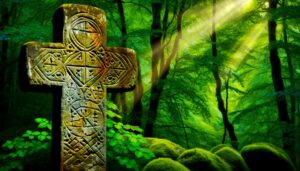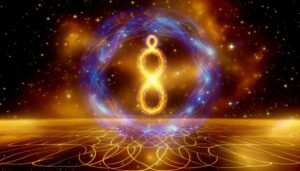7 Symbols of Life and Death Across Cultures
The symbols of life and death carry deep, cross-cultural significance. The Egyptian Ankh epitomizes eternal life and immortality, intertwined with both gender principles.
The skull, prevalent in memento mori art and Mexican Día de los Muertos, underscores life's transience. Yin and Yang symbolize balance and perpetual transformation.
The Celtic Cross merges pagan motifs with Christian elements, reflecting the eternal cycle of existence. Ouroboros, a serpent consuming its own tail, speaks to rebirth and continuity, while the Tree of Life illustrates interconnected existence across various traditions.
Exploring these symbols reveals profound insights into the universal themes of life and death.
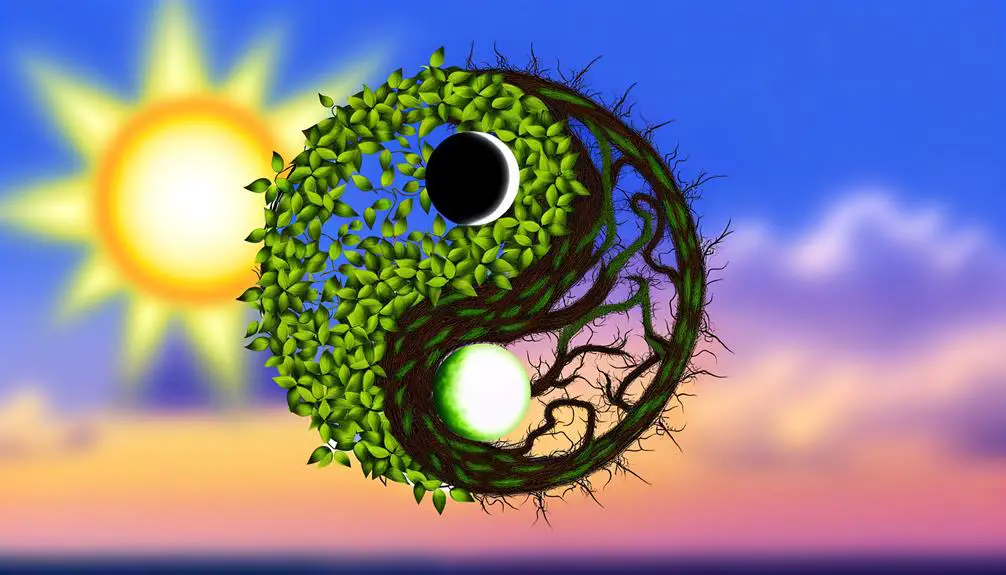
Key Takeaways
- The Egyptian Ankh symbolizes eternal life and the balance of masculine and feminine principles.
- The Skull symbol represents mortality, impermanence, and the interconnectedness of life and death.
- Yin and Yang illustrate the dualistic nature of existence and the balance between life and death.
- The Celtic Cross amalgamates pagan and Christian symbols, reflecting the eternal cycle of life, death, and rebirth.
- The Ouroboros, a serpent eating its tail, symbolizes rebirth, continuity, and the cyclical nature of existence.
The Egyptian Ankh
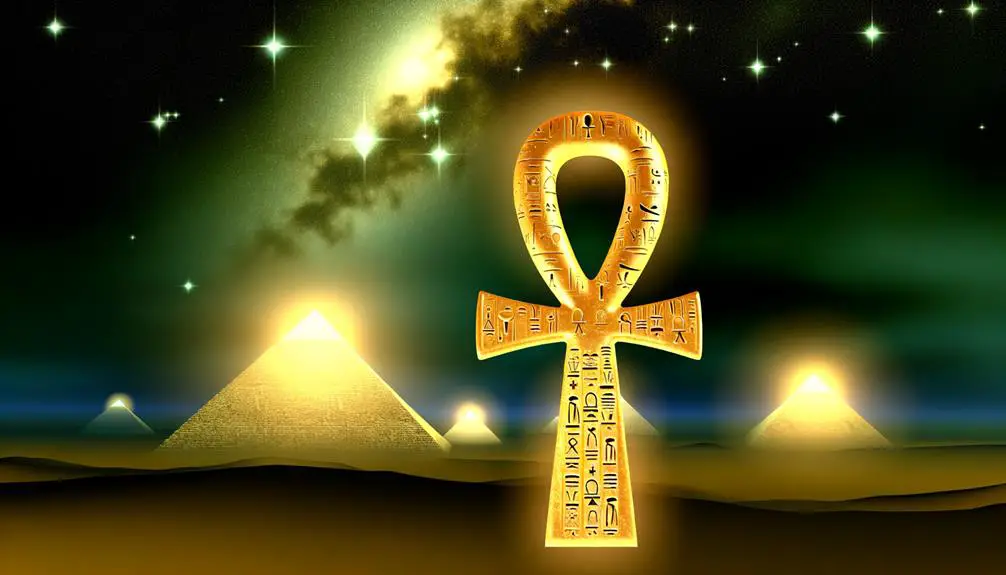
Widely recognized as a potent symbol of eternal life, the Egyptian Ankh seamlessly intertwines elements of religion, mythology, and cultural identity.
Archaeological evidence indicates its prominent use in ancient Egyptian art and hieroglyphs, where it symbolized life and immortality.
The Ankh's unique design, combining a cross with a loop, represents the union of masculine and feminine principles, suggesting a balance essential for life.
Contextually, the Ankh appeared frequently in funerary art, where deities such as Isis and Osiris were depicted holding it, signifying their divine authority to grant life beyond death.
This cultural emblem transcended Egypt, influencing Coptic Christianity and modern spiritual movements, thereby cementing the Ankh's enduring legacy as an icon of life and everlasting existence.
The Skull Symbol
The skull symbol, often depicted as a stark representation of mortality, transcends cultural boundaries, embodying a complex interplay of fear, reverence, and philosophical reflection on the nature of life and death.
In Western cultures, it frequently appears in memento mori art, reminding viewers of life's fleeting nature and the inevitability of death.
Conversely, in Mexican tradition, the skull is integral to Día de los Muertos, celebrating deceased loved ones and the continuity of life.
In Tibetan Buddhism, skull imagery in ritual objects underscores impermanence and the cyclical nature of existence.
Hence, the skull serves not only as a grim reminder of mortality but also as a symbol of veneration and an invitation to contemplate life's interconnectedness with death.
Yin and Yang
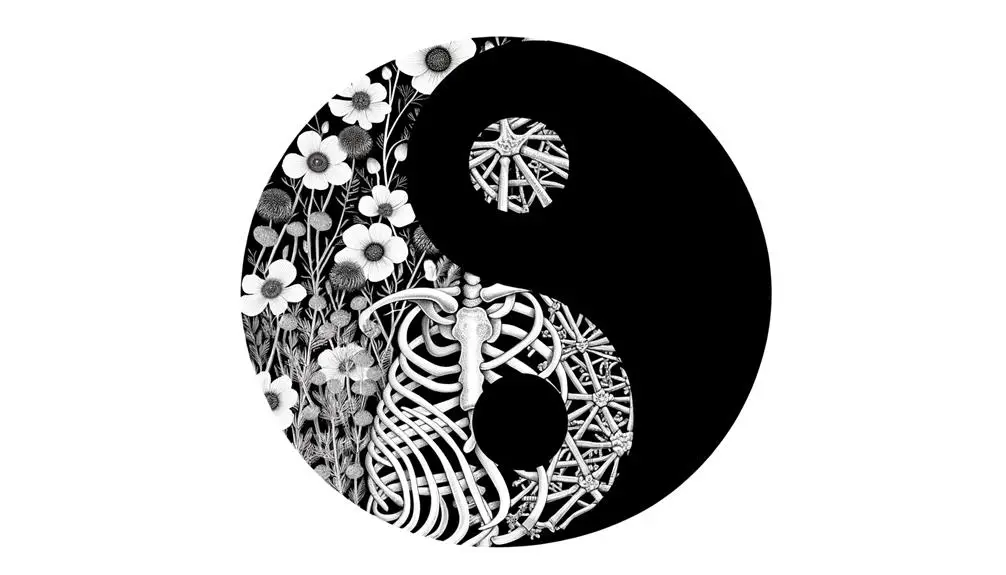
At the heart of Chinese philosophy, Yin and Yang symbolize the dualistic nature of existence, where opposing forces are interconnected and interdependent in the natural world.
This ancient concept embodies the balance between life and death, light and dark, and other polarities. In its well-known symbol, the black Yin and white Yang halves contain a dot of the opposite color, illustrating the presence of each within the other.
This principle transcends Chinese culture, influencing various fields such as medicine, martial arts, and cosmology. Yin and Yang's fluid dynamics underscore the perpetual transformation and equilibrium inherent in the universe, offering profound insights into the cyclical and harmonious nature of life, death, and rebirth across different cultural contexts.
The Celtic Cross
The Celtic Cross, a prominent symbol in both historical and contemporary contexts, offers a rich tapestry of meanings that span across various cultures. Its origins can be traced back to early Christian Ireland, where it amalgamated indigenous pagan symbols with Christian iconography to convey themes of life, death, and eternity.
Modern interpretations of the Celtic Cross continue to evolve, reflecting an ongoing dialogue between ancient traditions and contemporary spiritual and cultural expressions.
Historical Origins Explained
Emerging from the rich spiritual and artistic traditions of early medieval Ireland, the Celtic Cross stands as a symbol deeply intertwined with both pre-Christian and Christian iconography. Its distinct form, characterized by a ring intersecting the arms of a conventional cross, reflects a synthesis of pagan and Christian elements. The origins of the Celtic Cross can be traced to the 8th century, when it was mainly used as a monumental structure, often embellished with intricate knotwork and biblical carvings.
| Element | Description |
|---|---|
| Ring | Symbol of eternity and creation |
| Cross | Representation of Christian faith |
| Knotwork | Interconnected loops, symbolizing life |
| Biblical Carvings | Depictions of Christian narratives |
| Monumental Use | Typically found in graveyards and churches |
Understanding its historical context illuminates the profound cultural fusion and religious significance embodied by the Celtic Cross.
Symbolic Meanings Unveiled
Interwoven with layers of cultural and religious symbolism, the Celtic Cross encapsulates a dual narrative of life and death, reflecting its multifaceted role within both pagan and Christian traditions. This emblematic artifact is laden with profound meanings:
- Circular Halo: Represents the eternal cycle of life, death, and rebirth, suggesting a continuum rather than a definitive end.
- Intersecting Arms: Symbolize the intersection of the earthly and the divine, bridging mortal existence with spiritual transcendence.
- Intricate Knotwork: Embodies the complexity of life's journey, with interlacing paths signifying interconnected destinies.
Contextually, the Celtic Cross serves as a tribute to the syncretism between ancient Celtic beliefs and Christian iconography, harmonizing concepts of mortality and immortality across diverse cultural landscapes.
Modern Interpretations Today
Frequently reinterpreted across various cultures, the Celtic Cross today embodies a rich tapestry of meanings, blending historical reverence with contemporary spiritual and artistic expressions.
In modern contexts, it transcends its Christian origins, symbolizing not only faith but also unity, eternity, and cultural heritage. Artistic renditions often incorporate intricate knotwork and other Celtic motifs, reflecting a deep connection to ancient traditions.
In different cultural settings, the cross is adopted as a symbol of protection and guidance, bridging the gap between the earthly and the divine. Its presence in jewelry, tattoos, and art signifies personal and collective identity, merging historical authenticity with modern relevance.
This enduring symbol continues to resonate, adapting to the evolving landscape of global cultural expression.
The Ouroboros
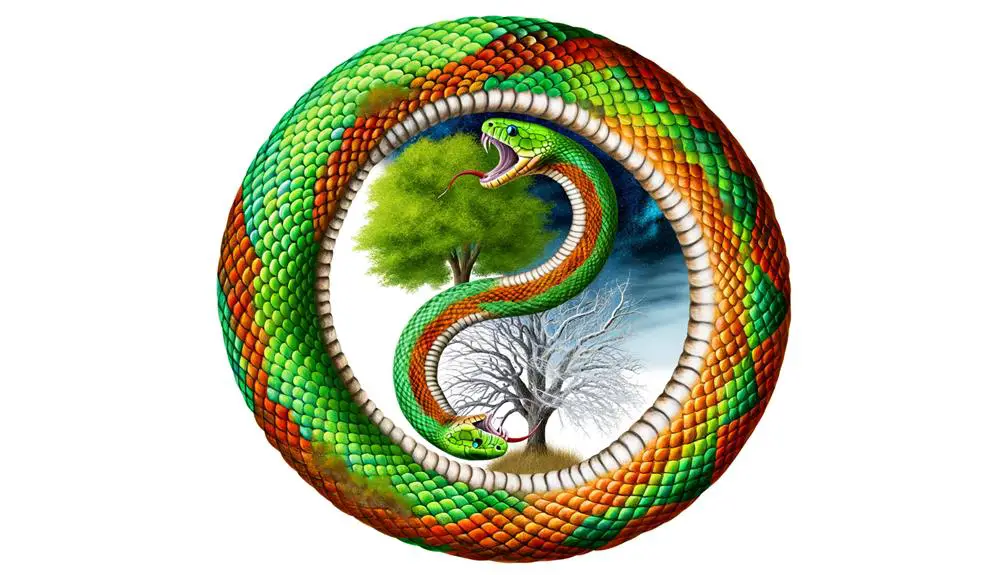
The Ouroboros is an ancient symbol that depicts a serpent eating its own tail. It embodies profound concepts such as rebirth, continuity, and the eternal cycle of life and death. Originating in Egyptian iconography and later adopted by Greek alchemists, it is a powerful representation of cyclical nature that transcends cultural boundaries.
Modern interpretations of the Ouroboros vary widely. They range from philosophical reflections on infinity to ecological symbolism and even personal transformation.
Ancient Symbolism Significance
Across various ancient cultures, the Ouroboros—a serpent or dragon swallowing its own tail—emerges as a profound symbol encapsulating the cyclic nature of life, death, and rebirth. Its significance traverses multiple civilizations, each attributing unique yet interconnected meanings to this enigmatic figure.
Ancient Egypt: The Ouroboros appears on tombs, symbolizing the eternal cycle of the soul.
Greek Alchemy: It signifies the concept of 'one is all,' reflecting the unity of all things.
Norse Mythology: Jörmungandr, the world serpent, encircles the earth, representing the boundary of the known world.
These cultural contexts emphasize the Ouroboros as not merely an emblem but a philosophical reflection on existence's perpetual continuity.
Cyclical Nature Representation
Examining the Ouroboros through the lens of its representation of the cyclical nature of existence, one finds a unified thread that weaves through the tapestry of diverse cultural narratives.
In ancient Egyptian iconography, the Ouroboros symbolized the eternal cycle of life, death, and rebirth, encapsulating the infinite nature of the universe.
Similarly, in Greek alchemical traditions, it represented the concept of unity of all things, material and spiritual, perpetually renewing themselves.
The Norse mythological context interprets it as Jörmungandr, the world serpent, encompassing the boundary of the earth and sea, reinforcing the idea of cycles and endings that are beginnings.
This cross-cultural presence underscores its profound resonance in human understanding of life's perpetual continuity.
Modern Interpretations Varieties
In contemporary discourse, the Ouroboros has evolved to embody a plethora of interpretations, reflecting nuanced understandings of cycles and regeneration in various cultural and philosophical contexts. This ancient symbol, often depicted as a serpent or dragon eating its own tail, continues to resonate deeply in modern times.
Interpretations include:
- Personal Growth: Representing the ongoing journey of self-improvement and transformation.
- Environmental Philosophy: Symbolizing the interconnectedness of ecosystems and the importance of sustainability.
- Technological Advancement: Emblematic of the iterative nature of innovation and the continuous feedback loop in development.
The Tree of Life
The Tree of Life, a symbol deeply embedded in various cultural and religious traditions, represents the interconnectedness of all living things and the cyclical nature of existence.
In Norse mythology, Yggdrasil, the immense ash tree, connects the nine worlds, signifying cosmic order.
In Christianity, the Tree of Life appears in the Garden of Eden, embodying eternal life.
Similarly, in Kabbalah, the Tree of Life illustrates the divine emanations through which the Infinite reveals itself.
Ancient Egyptians revered the Sycamore tree as a symbol of death and rebirth.
This rich symbolism underscores universal themes: life, death, and continuity. Each tradition, while contextually unique, converges on the idea that existence is a web of interdependent relationships, continuously evolving.
Conclusion
In the grand tapestry of human culture, symbols such as the Egyptian Ankh, the Skull, Yin and Yang, the Celtic Cross, the Ouroboros, and the Tree of Life serve as vivid allegories for the cyclical nature of existence.
These emblems traverse geographical and temporal boundaries, embodying the eternal dance between life and death.
Each symbol, a thread, weaves a rich narrative that reflects humanity's perennial quest to understand the mysteries of birth, mortality, and rebirth.

